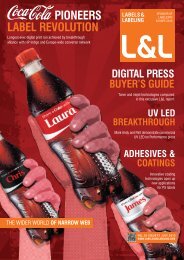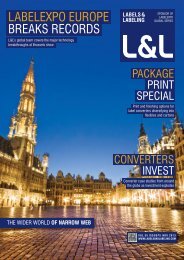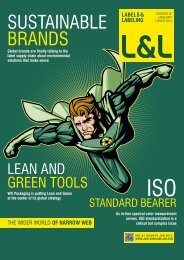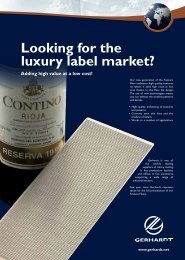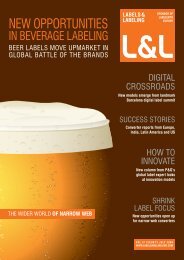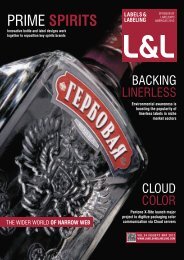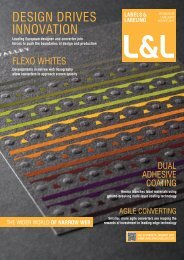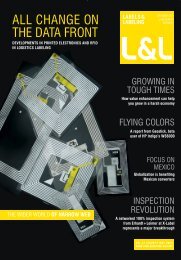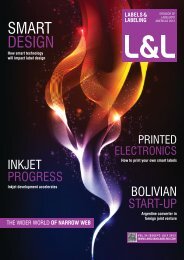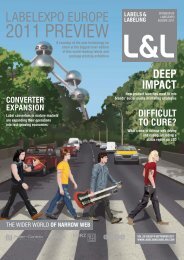SELL
Download - Labels & Labeling
Download - Labels & Labeling
- No tags were found...
Create successful ePaper yourself
Turn your PDF publications into a flip-book with our unique Google optimized e-Paper software.
LABELS&LABELING |81<br />
prints labels at 720 x 720 dpi. With a wide<br />
variety of available substrates – paper,<br />
polyester and polypropylene – the system<br />
can print in widths from four inches<br />
(102mm) to eight and a half inches<br />
(216mm) in rolls with a maximum outside<br />
diameter of 11 inches (280mm).<br />
Ashe Converting Equipment demonstrated<br />
an Opal slitter rewinder equipped<br />
with a 100 percent inspection system<br />
from German company Eye-C, thanks<br />
to a new reciprocal partnership between<br />
the companies which also saw Eye-C run<br />
an Ashe rewinder on its own stand. The<br />
machine can process any substrate up to<br />
widths of 600mm.<br />
Also on display was a servo-driven<br />
Opal 330 with die station for blank and<br />
pre-printed labels, as well as a Solitaire<br />
filmic slitter which can handle web widths<br />
of 400-800mm.<br />
Aztech Converting showed an ISR slitter<br />
rewinder with 100 percent inspection<br />
from Erhardt + Leimer, and a BSR dual<br />
spindle slitter rewinder, which can handle<br />
all substrates including unsupported film.<br />
The ISR range has a maximum speed<br />
of 243 m/min and the BSR of 228 m/min.<br />
Bar Graphic Machinery showed its<br />
latest digital finishing converting line, the<br />
BGM Elite FDTR Flexo Die Cut. Standard<br />
features are being able to print to<br />
re-register, die-cut to print re-register and<br />
print to print re-register; the servo-driven<br />
print stations are equipped with self-positioning<br />
print cylinders enabling automatic<br />
print registration set up. The machine is<br />
fitted with interchangeable UV and IR curing<br />
cassettes, while dual servo-driven die<br />
stations with removable anvils enable all<br />
converting options to be achieved.<br />
Other models exhibited from the Elite<br />
Range were a filmic inspection slitter rewinder,<br />
inspection slitter rewinder, rotary<br />
die-cutting rewinder and die-cut to register<br />
slitter rewinder. By mid-way through<br />
day two of the show, the company reported<br />
two sales off the booth to L&L.<br />
Cartes launched a new version of its<br />
Laser 350 RF laser die-cutting machine.<br />
Also on display was Cartes’ HS Combi-<br />
Laser Series, where laser technology is<br />
combined with printing units to create<br />
modular machines for label production<br />
which can reach speeds of up to 15,000<br />
cycles per hour. The HS CombiLaser<br />
Series features different applications<br />
such as converting and die-cutting by<br />
traditional flat die or laser, UV varnishing,<br />
corona and primer pre-treatments, silkscreen<br />
printing, hot stamping, embossing,<br />
lamination and hologram application.<br />
Cartes reported numerous sales during<br />
the show. Belgium-based Femaprint purchased<br />
a Laser 350 Dual RF; Lenzlinger<br />
of Switzerland bought a Laser 350 Dual;<br />
French converter Neo-Color ordered a<br />
TFE 350 electronic sheeter; Brazil-based<br />
Indústria de Etiquetas Romano opted for<br />
a HS203SHH label converting line with<br />
hot stamping, embossing and flat-bed<br />
die-cutting; and Mexican converter Etiquetas<br />
Modernas purchased a HS352SS<br />
system which allows fine silkscreen<br />
decoration, Braille embossed effects and<br />
complete or spot varnishing.<br />
Colordyne demonstrated its new CDT-<br />
1600PC (production class) roll-to-roll<br />
press dedicated to the prime and secondary<br />
pressure sensitive label markets,<br />
narrow web packaging and tags.<br />
Show attendees saw for the first time<br />
Colordyne’s inkjet system using Memjet<br />
color printing technology mounted on<br />
a specially engineered web handling<br />
system in cooperation with AzTech<br />
Converting.<br />
The 1600PC is a 5-color fixed head<br />
system equipped with CMYK waterbased<br />
dye ink, plus a water-based dye<br />
pantone spot color capable of running at<br />
32 in/sec, or 160 ft/min on both continuous<br />
and pre-die cut materials. Memjet’s<br />
printheads utilize nanotechnology that<br />
can print at 1600 x 1200 dpi on this<br />
system. Memjet-powered printers use<br />
Memjet printheads, controller chips and<br />
ink. The Memjet printhead is 8.77 inches<br />
wide and has 70,400 nozzles that can fire<br />
more than 700 million drops of ink per<br />
second. With its five printheads, the CDT-<br />
1600PC can fire more than three and a<br />
half billion drops of ink per second.<br />
This digital inkjet system is poised to<br />
tackle two separate pieces of market<br />
share. Firstly, the Colordyne system can<br />
offer a turnkey solution to brand owners<br />
of all sizes that help improve turnover<br />
times, reduce inventories and waste and<br />
provide a production avenue for more<br />
cost-effective full color labels. Since the<br />
system is capable of printing pre-die cut<br />
materials, the complex conversion step is<br />
removed from on-demand label production,<br />
thereby streamlining the process.<br />
The Colordyne 1600PC has been<br />
designed with flexibility in mind and with<br />
the AzTech Converting partnership, label<br />
converters too can find the system to be<br />
a simplified process, but can additionally<br />
customize the converting line by adding<br />
stations to the front and back of the digital<br />
heads with options to coat, laminate,<br />
integrate foiling, stamping and/or die<br />
stations to produce more short runs of<br />
high-value labels cost effectively.<br />
The way in which the Colordyne system<br />
has been designed around low capital,<br />
consumable costs and profitability is<br />
different from others in the market. Inks,<br />
materials and the inkjet head are considered<br />
consumables and are factored in as<br />
such within the cost model. The Memjet<br />
heads in the Colordyne system can be<br />
replaced for a minimal cost, which lowers<br />
the cost per print.<br />
Convertec unveiled its new modular<br />
unit for digital Braille printing for labels.<br />
The unit, called DigiBraille, has a modular<br />
design that can be retrofitted to any<br />
printing press or converting line for either<br />
in-line or off-line Braille production. The<br />
central impression design allows booklets<br />
and labels to be printed with greater<br />
accuracy while also inspection is done<br />
on the same drum.<br />
The CI unit was possible to make due<br />
to an innovative printing head design.<br />
The smaller printing head also allows<br />
for increased speed and tighter tolerances.<br />
The basic software for the new<br />
DigiBraille module can handle up to 12<br />
labels across the web, printing up to 24<br />
text lines of Braille simultaneously. The<br />
extended software can handle upload of<br />
PDF´s and XML data to avoid operator<br />
programming errors.<br />
A separate camera inspection system<br />
is available that can cross-check the<br />
printed Braille text image against a master<br />
image. If any errors occur, they can<br />
be marked and taken out further down<br />
the process.<br />
Daco Solutions launched the Spectrum<br />
servo-driven single color flexo<br />
press with re-register capabilities. The<br />
Spectrum can take digital print from a<br />
variety of digital presses, apply a varnish<br />
or overlaminate and die-cut to register. It<br />
is also capable of producing single color<br />
flexo labels and die-cut or using the reregister<br />
system add further colors, or just<br />
simply die-cut plain labels.<br />
The company’s DTD250 table-top<br />
finishing machine has had various<br />
upgrades, with an air mandrel for the<br />
unwind, a new draw/nip roller configuration,<br />
guarding modification enabling<br />
RotoMetrics Hydra Jacks to be fitted at<br />
a later date by the client and a Daco designed<br />
back scoring system. A PLD250<br />
semi-automatic turret rewinder was also<br />
on display with upgraded software.<br />
Daco signed an order with Sapir Sprint,<br />
Israel, for a Daco DTD250 within 30 minutes<br />
of the doors opening at Labelexpo<br />
Europe.<br />
Sapir Sprint produces thermal transfer<br />
labels for a range of desktop and industrial<br />
printers. Sapir Sprint’s Ronen Gidony<br />
said: ‘We bought one of the first Daco<br />
DTD250 machines back in 2003 when<br />
the machine was first introduced to the<br />
SOMA Engineering's Bulldog offline die-cutter



